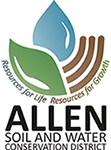Using Less Salt Helps Protect Our Waterways
By Community Outreach Coordinator Casey Heilman
The midwest winter can be tough on our communities. Sodium Chloride or road salt is used to keep driveways and sidewalks safe, but the cost of using too much salt goes far beyond the pavement. Excess salt can damage vehicles, harm pets, and plants, and end up in our waterways. Using the right amount can help to protect our watershed, save money, and keep you safe. This winter, keep in mind the four S’s of using salt to help reduce your impact on our environment
SHOVEL
Remove all snow from your driveway and sidewalks before it has a chance to turn to ice. Salt should be used after the snow has been removed.
SIZE
More salt does not mean more melting. A 12-ounce coffee mug of salt is typically enough to melt the snow and ice from a 20-ft driveway or about 10 sidewalk squares. It should be spread so there are about 3 inches of space between each grain of salt. Applying excess salt can harm your lawn, flower beds, trees, and can cause pollution to nearby streams. Just one teaspoon of salt permanently pollutes 5 gallons of water
SWEEP
If there is leftover salt on the ground after the snow and ice melts, then you’ve used too much.
Sweep up leftover salt and next time apply less.
SWITCH
Salt only works in temperatures above 15 degrees Fahrenheit. For colder temperatures use a small amount of sand or choose a difference deicer formulated for colder conditions.
Remember, everything that goes down the stormdrain ends up in the river. That includes salt, melted salty ice, and snow. All of these things contribute to polluting clean water. So, this winter, don’t over season your sidewalk and use the right amount of salt.


Leave A Comment